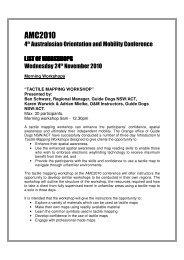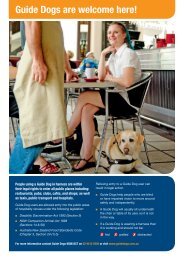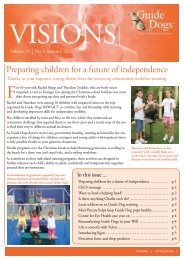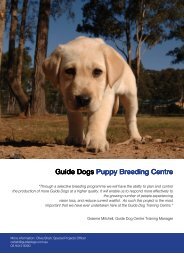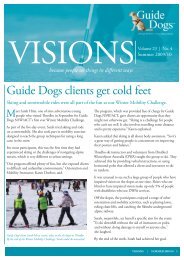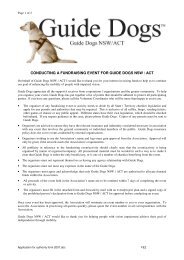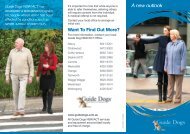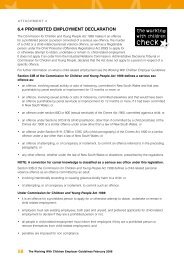AMC2010 - Guide Dogs NSW/ACT
AMC2010 - Guide Dogs NSW/ACT
AMC2010 - Guide Dogs NSW/ACT
Create successful ePaper yourself
Turn your PDF publications into a flip-book with our unique Google optimized e-Paper software.
The aim of this study was to investigate whether<br />
objective laterality measures could be employed<br />
by <strong>Guide</strong> Dog Organisations to identify dogs with a<br />
high probability of success in the training program.<br />
2:00pm Session 5, Forum C: Program<br />
evaluation. Room: Library<br />
1. Title: A Case Study to Outline the O&M<br />
Programs for a Mature Lady who Became<br />
Totally Blind following a Long History of Living<br />
with Low Vision<br />
Author: Judy Rogers, O&M Instructor, <strong>Guide</strong> <strong>Dogs</strong><br />
<strong>NSW</strong>/<strong>ACT</strong><br />
Summary: She has a busy lifestyle and is actively<br />
involved in the community. The client lives alone<br />
with the support of a part-time carer. She is also<br />
a double amputee. It is her aim to live an active,<br />
independent life. This study outlines different<br />
aspects of her journey, including:<br />
1. MOBILITY: Mobility programs using: (1) walker;<br />
(2) wheel-chair<br />
Basic O&M skills including use of echo-location,<br />
sense of direction and straight line walking were<br />
integral to the success of this program.<br />
2. ORIENTATION PROGRAMS: When the client<br />
was required to move at short notice, basic<br />
orientation methods were used in conjunction<br />
with tactile maps. The client had to learn and then<br />
relearn these new areas using both mobility aids<br />
and changing vision.<br />
3. ACCESS ISSUES: Access issues became a<br />
major concern when the new unit was not suitable.<br />
The client has been actively involved in solving the<br />
problems and finding solutions.<br />
2. Title: Ability to Get About as a Global<br />
Measure of Outcome for O&M with Older<br />
Persons<br />
Author: Steve La Grow, School of Health and<br />
Social Services, Massey University, NZ<br />
Summary: Measures of both adaptation to the<br />
onset of disability and quality of life (global and<br />
condition specific) have been used as outcome<br />
measures to evaluate rehabilitation programs for<br />
older persons in general and vision rehabilitation<br />
programs specifically.<br />
Identifying a defining measure for evaluating O&M<br />
programs, however, has proven to be quite elusive.<br />
We have in the past sought to measure the impact<br />
of O&M on (a) safety, (b) speed, (c) efficiency, (d)<br />
ease or comfort, (f) independence, (g) frequency,<br />
and (h) breadth of travel. All of which relate to the<br />
goals of O&M, but none of which, on its own,<br />
appears to be global enough to capture the<br />
essence of what we are trying to achieve<br />
with O&M.<br />
One possibility is a single-item measure of one’s<br />
perception of his or her ability to get around (i.e.<br />
How well are you able to get around?).<br />
The purpose of the study reported here was to<br />
assess the degree to which it contributes to the<br />
prediction of self-assessed quality of life among<br />
older persons who report difficulty seeing as a first<br />
step in assessing its potential as a global outcome<br />
measure for O&M.<br />
3. Title: A Snapshot of Australian Childhood<br />
Vision Impairment<br />
Author: Sue Silveira, Renwick Centre, Royal<br />
Institute for Deaf and Blind Children, Sydney<br />
Abstract: The Australian Childhood Vision<br />
Impairment Register is the first register to capture<br />
information on children who live with vision<br />
impairment in Australia. The Register is sponsored<br />
by the Royal Institute for Deaf & Blind Children, in<br />
partnership with eye health professionals, health<br />
providers, low vision agencies and<br />
service providers.<br />
The Register is collecting data on children living<br />
with vision impairment and their health, social<br />
and educational requirements across Australia.<br />
This data is then used for service planning and<br />
also research into conditions which cause vision<br />
impairment. Children and their families have been<br />
invited to register since June 2009 and interesting<br />
trends about vision impairment have started<br />
to emerge.<br />
This presentation will inform the O&M Instructor<br />
on current findings from the Register to provide<br />
a snapshot of the Australian situation. Ideas for<br />
opportunities for research collaboration will also<br />
be discussed.<br />
Thank you for attending <strong>AMC2010</strong>, have a safe trip home<br />
30



